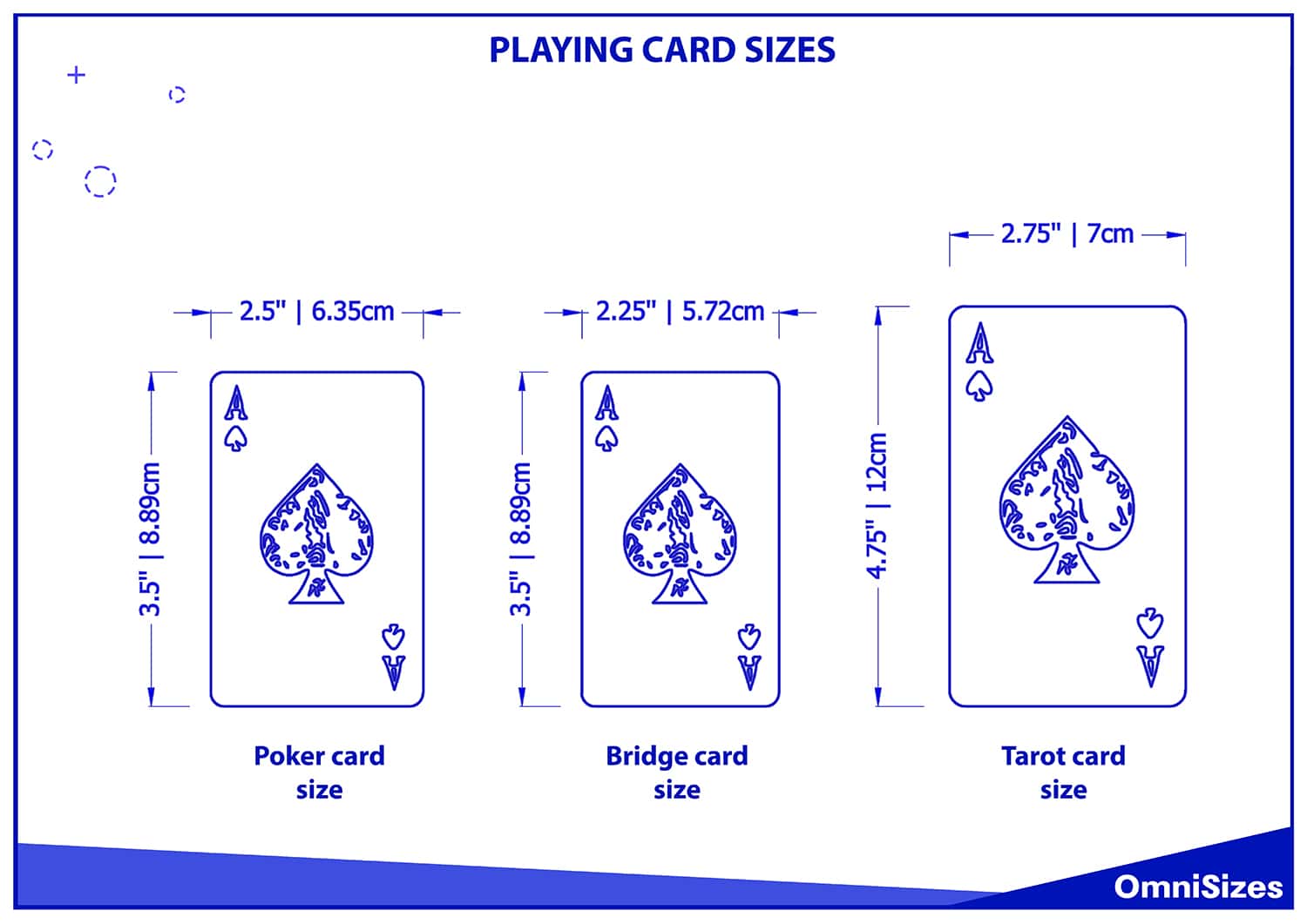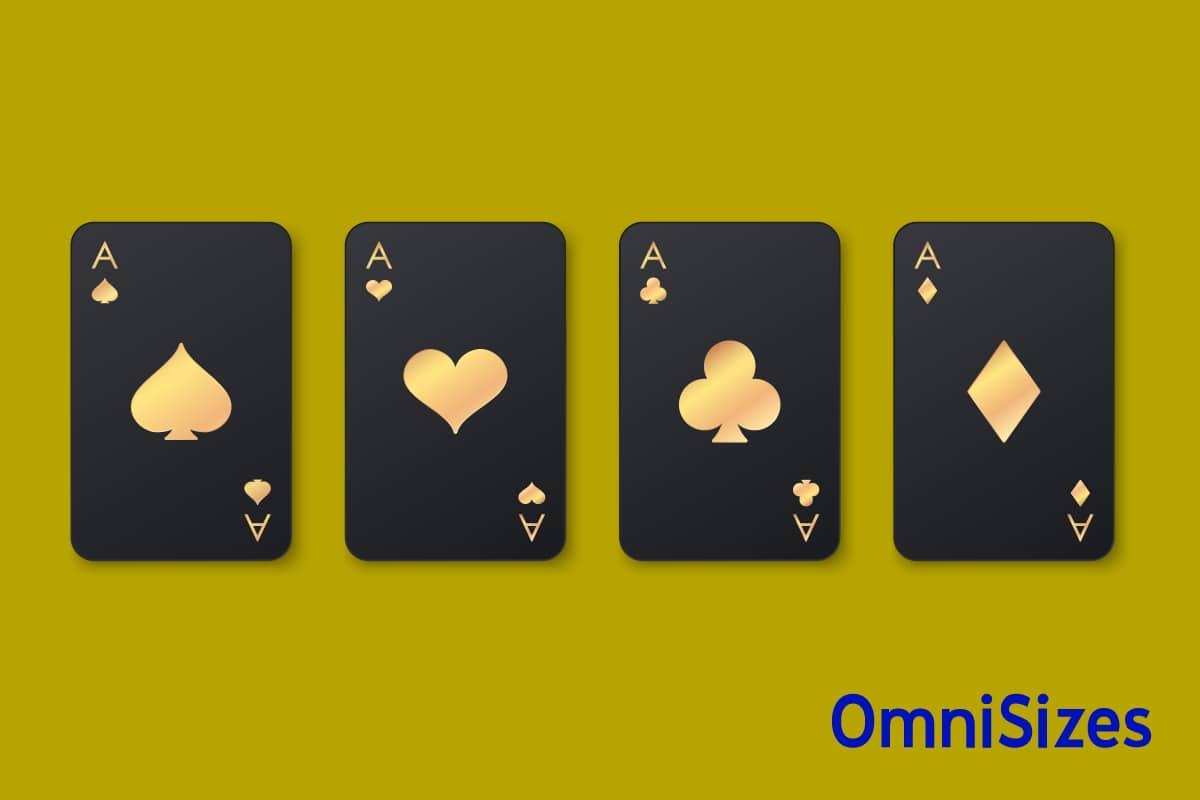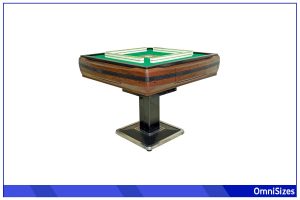Playing cards are a staple in homes, casinos, and gaming venues worldwide. Playing card sizes, a seemingly small detail, have a significant impact on the enjoyment and functionality of card games.
Most standard playing cards come in two sizes: Poker size, measuring 2.5 × 3.5 inches (6.35 × 8.89 cm), and Bridge size, slightly narrower at 2.25 × 3.5 inches (5.72 × 8.89 cm).
This guide will explain playing card sizes in more detail, how the materials can affect size, and how you can customize your own set of playing cards.

Standard Playing Card Sizes
Playing cards are a blend of history and art. The two most common sizes are Poker and Bridge, each with slightly different measurements.
Poker Size Cards
Poker size cards measure 2.5 × 3.5 inches (6.35 × 8.89 cm). This size is widely recognized and used in various card games, not just poker. Their slightly wider dimensions make them ideal for games where players hold fewer cards in their hands.
The larger size also allows for more intricate designs and clearer visibility of suits and numbers, making them popular for custom decks and collectible card games. Poker size cards are preferred in casinos and professional tournaments as their size makes them easier to shuffle and handle.
Bridge Size Cards
Bridge size cards are 2.25 × 3.5 inches (5.72 × 8.89 centimeters). As the name suggests, they are commonly used for the game of bridge. The narrower width is designed for ease of handling, especially in games where players have to hold many cards at once, like in bridge, where a player can hold up to 13 cards.
This size is also favored in other trick-taking games and is appreciated by people with smaller hands. Despite the smaller width, bridge cards maintain the same length as poker cards.
Specialty and Regional Card Sizes
Playing cards also come in a variety of shapes and sizes that reflect the diversity of card games around the world.
Tarot Card Sizes
Tarot cards, known for divination and storytelling, are typically larger than standard playing cards, averaging around 2.75 × 4.75 inches (7 × 12 cm). This size provides more space for intricate artwork and symbolism, which is crucial for the interpretive nature of tarot readings.
European Card Sizes
European playing cards exhibit a remarkable variety in size and design, reflecting the continent’s diverse card-playing traditions. For example, French playing cards are usually 2.24 × 3.46 inches (57 × 88 mm), slightly narrower than poker cards. German cards, often used for Skat, are typically 2.32 × 3.58 inches (59 × 91 mm).
Asian Playing Card Sizes
Asian playing cards often differ significantly from their Western counterparts in both size and material. For instance, Japanese Hanafuda cards are much smaller, measuring about 1.33 × 2.25 inches (34 × 57 mm).
In China, Mahjong cards, a card-based variant of the traditional Mahjong tiles, have their unique dimensions and are typically made from thicker material.
Material and Quality of Playing Cards
The material and quality of playing cards directly influence their size and usability. Different materials affect not only the feel and handling of the cards but also their overall dimensions and longevity.
Card Material and Thickness
Playing cards are typically made from two types of material: paper and plastic.
Paper cards, the most common, are often coated with a thin plastic layer for durability. The thickness of paper cards can vary, but they generally range from 0.17 to 0.24 mm.
Plastic cards are more durable and resistant to bending and moisture. They are usually thicker, around 0.25 to 0.32 mm, and provide a different tactile experience.
How Quality Affects Card Size and Feel
Higher-quality cards often have a more consistent size and shape, with precise cutting and fewer imperfections. Finishes can also affect the thickness of the card, as multiple layers of coating add slight but noticeable differences in card dimensions.
Making Your Own Playing Cards
Creating your own playing cards is a fun and creative way to personalize your gaming experience.
Designing Your Cards: Artwork and Layout
The first step in making your own playing cards is designing the artwork and layout. You can use graphic design software or even hand-draw your designs. Consider the style, colors, and imagery you want to use. The design should include the suits and numbers for traditional card games or unique imagery for custom games.
The standard size for playing cards is 2.5 × 3.5 inches for poker cards and 2.25 × 3.5 inches for bridge cards, but you can choose different dimensions for a unique deck.
Choosing the Right Material
The most common materials are cardstock and plastic. Cardstock is easier to print on and is ideal for homemade cards, but it’s less durable than plastic. Plastic cards last longer and are waterproof, but they are harder to print on and typically require professional manufacturing.
Printing and Cutting Your Cards
If you have a high-quality printer, you can print them at home. Otherwise, you might consider using a professional printing service. Make sure to print your designs with high resolution to ensure the images and text are clear. Cutting the cards can be done with a precise cutter or scissors. For a professional look, round the corners of the cards with a corner cutter.
Adding a Finish for Durability
A finish can enhance the durability and feel of your cards. You can apply a clear varnish or laminate them for extra protection. This step is particularly important if you’re using cardstock, as it will make the cards more resistant to wear and tear. A finish also provides a smoother surface for shuffling.






